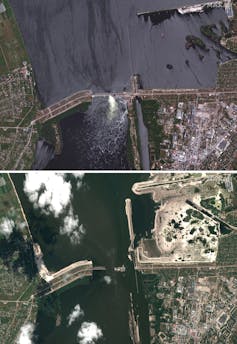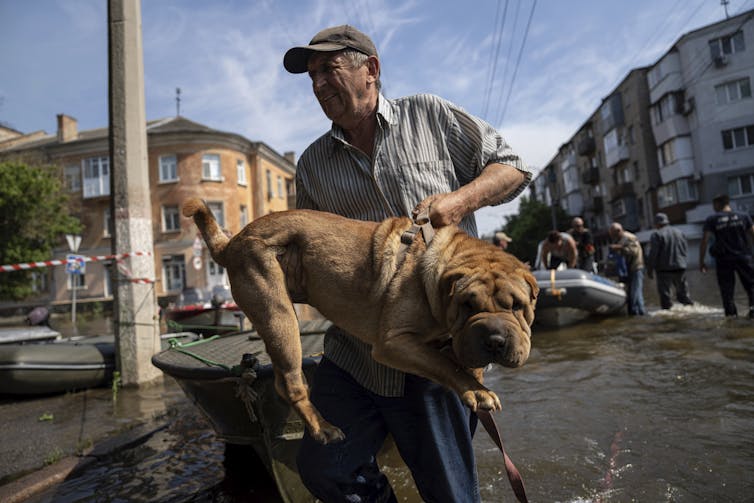

When the dam was under construction, the oppression of Josef Stalin’s rule and the suffering of the Nazi invasion seemed over



Whoever destroyed it, the fall of the 67-year-old Kakhovka Dam stands as a symbol of the final death of the Soviet dream of inter-ethnic and constructive co-operation.
The Soviet Union, which was dismantled in 1991, was more colonial than co-operative, more about oppressive politics than constructive economics.
Yet the dream of Soviet-style harmony and co-operation still endured through much of the 20th century in many parts of the world. It explains part of the continued appeal of Russia in areas of the Global South even today.
The Kakhovka Dam was one of the dream’s symbols. A look at the opening of the dam in 1956 shows what once inspired so many, despite Soviet crimes like the Holodomor, the starvation of millions of Ukrainians in 1932–33 as a result of Soviet policies.
When the dam was under construction, the oppression of Josef Stalin’s rule and the suffering of the Nazi invasion seemed over. The Soviet Union had ended its international isolation.
Under Ukrainian-born leader Nikita Khrushchev, the Soviet Union took part for the first time in United Nations development aid after a deal worked out by the United Nations’ aid chief, Canadian Hugh Keenleyside.

In 1955, a UN mission, mainly composed of officials from India, toured the Soviet Union, marvelling at economic progress in the non-Russian republics — Uzbekistan, Georgia and, above all, Ukraine. Visiting “the great mining and metallurgical complex” of Ukraine’s Dnipro River, tour leader Eleanor Hinder raved about miraculous, co-operative development in action.
After a cruise down the river, navigable from Kyiv to the Black Sea, the UN group gathered at the site of the Kakhovka Dam to witness the latest addition to what Hinder called the “tremendous concept” of the Dnipro hydro-electric and irrigation complex in her travel diaries.
The rebuilding of the cascading Dnipro dam series began in the aftermath of the German invasion of the Soviet Union, with retreating Nazi troops still close by. Industry was booming. Water channels fanned out “to irrigate Ukrainian territory,” Hinder wrote, which bloomed “deep yellow over great expanses” under blue skies. Electrical power lines criss-crossed the Ukrainian prairie, allowing people some “release from human burdens.”
The dam had already spawned, she wrote, the “very pleasant city” at Kakhovka. The conflict of the recent past was giving way to co-operation.
A group of 4,000 Ukrainian women had begun the post-Second World War reconstruction. Aid then flowed in from Russia in an example of what Hinder called inter-Soviet co-operation. “No wonder they are proud of it, and of the people who carried it out,” she wrote.
Hinder, an Australian woman working for the UN’s technical assistance branch, had the same impressions as many visitors before her. A lesbian and feminist, she noticed the greater acceptance of women and homosexuality in the Soviet Union compared to the United States.
Her story could just as easily have been written by others who visited the dam while it was under construction, whether from Sweden, Britain, Poland, Italy or China. Like them, Hinder was “overwhelmed with Ukrainian hospitality, even vodka at breakfast.”
This is not to suggest that there was genuine co-operation in the Soviet Union or that the various non-Russian republics had any real independence. Instead, it highlights how Soviet development was perceived by some international audiences. There was global admiration for rapid economic development in the early Soviet Union. Dams were a big part of that.
After the defeat of Nazi Germany, and even amid the Cold War, many admired the Soviet experiment for its apparent co-operation among developed Russia and the less developed republics to its south.
This is evident in the Soviet Union’s role in convening the 1920 Congress of the Peoples of the East in Baku, Azerbaijan. The Soviets encouraged anti-colonial struggles in Asia and Africa, including the independence of Indonesia from Dutch rule — among the first colonial disputes to come up at the UN Security Council.
Economic progress, claims of inter-ethnic harmony and anti-colonialism mingled to build a positive Soviet reputation in the Global South. This was not a Russian effort, but one that featured voices from the non-Russian Soviet republics. It was a Ukrainian delegate to the UN, for example — Dmitry Manuilsky — who led the charge for Indonesian independence.

Symbols of Russian-Ukrainian co-operation, such as the Kakhovka Dam, stood at the core of the Soviet global appeal. As a result of such projects, Soviet aid was welcomed in India, Indonesia and elsewhere.
The death of the dam amid a war of Russian aggression is as good a symbol as any of the death of Russian-Ukrainian co-operation.
The Kahkovka legacy helps explain why Global South countries seek to act, in the words of the Indonesian president, as a Russian-Ukrainian “bridge of peace” even while condemning Russian aggression.![]()
David Webster, Associate professor, Human Rights Studies, King's University College, Western University
This article is republished from The Conversation under a Creative Commons license. Read the original article.
We are a voice to you; you have been a support to us. Together we build journalism that is independent, credible and fearless. You can further help us by making a donation. This will mean a lot for our ability to bring you news, perspectives and analysis from the ground so that we can make change together.

Comments are moderated and will be published only after the site moderator’s approval. Please use a genuine email ID and provide your name. Selected comments may also be used in the ‘Letters’ section of the Down To Earth print edition.